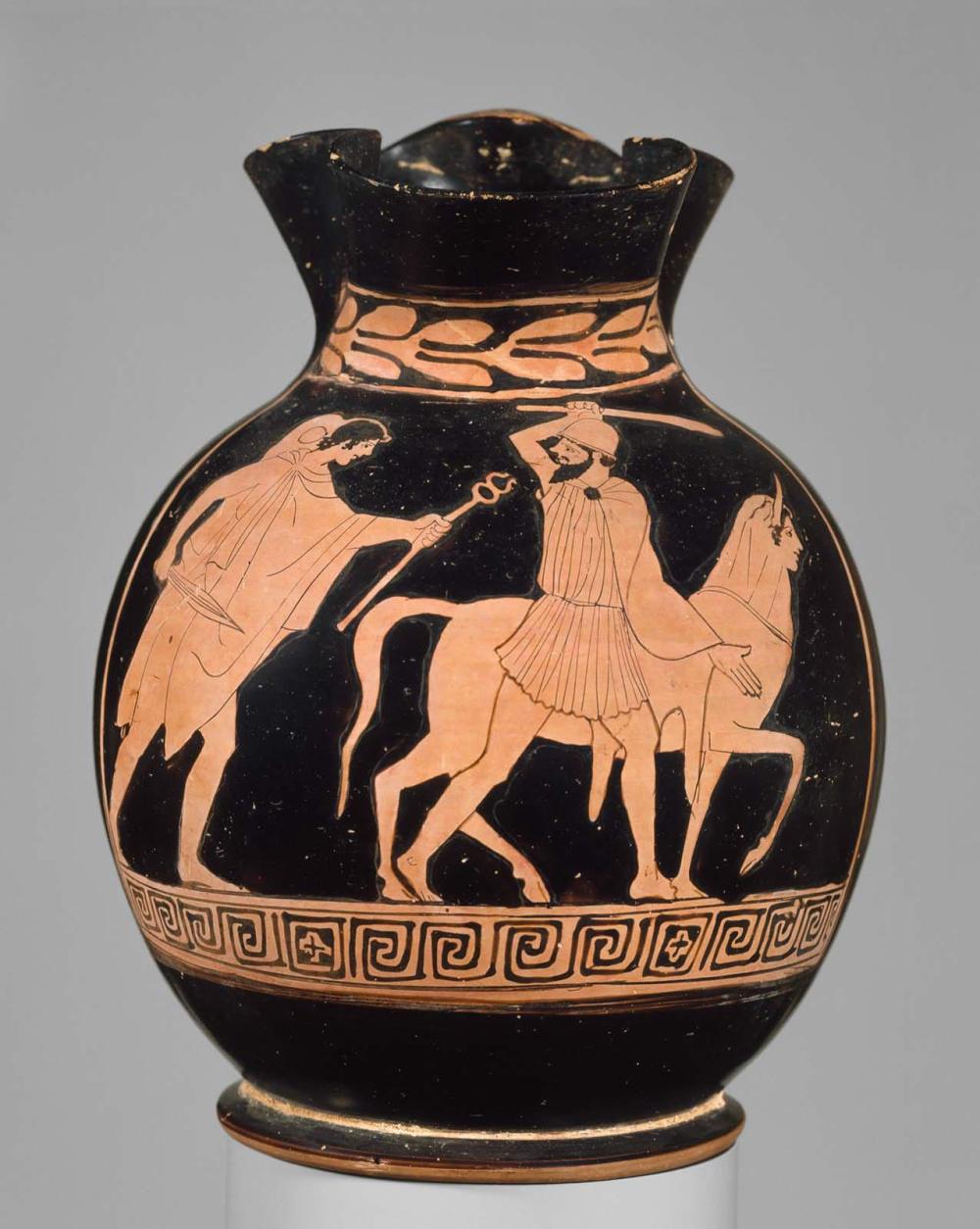Advanced Search 

View: Front
Pitcher (oinochoe)
Greek, South Italian
Early Classical Period
about 445–430 B.C.
Place of Manufacture: Italy, Lucania
Medium/Technique
Ceramic, Red Figure
Dimensions
Height: 22.7 cm (8 15/16 in.)
Credit Line
Henry Lillie Pierce Fund
Accession Number00.366
NOT ON VIEW
CollectionsEurope, Ancient Greece and Rome
ClassificationsVessels
Catalogue Raisonné
Vase-Painting in Italy (MFA), no. 001.
DescriptionITALIAN VASE PAINTING in ITALY, #1 (00.366)
Oinochoe (shape 3)
Attributed to the Pisticci Painter
Early Style. about 450 B.C.
Io, in the form of a cow, is being driven along by Argos, who stands in the foreground. Hermes follows from the left, his herald's staff in his extended left hand, his sword drawn back in his right. Argos looks back at Hermes and with his right hand raises his staff over his head to defend himself. Argos wears a chitoniskos, a cap of wool or skin, and a cloak of skin pinned at the throat. Hermes wears a chlamys and petasos. The drawing is in the Attic style, but unlike most Athenian renderings of the myth, Io is given a human face, and Argos is not panoptes.
The picture has lateral frames of narrow reserved lines. The upper frame is a large laurel wreath. The broad groundline consists of groups of four linked maeanders to right alternating with cross-squares. On top of the handle, where it meets the rim, is an enclosed, upright palmette.
Trendall and Webster (Illustrations, p. 32) thought it possible this picture was inspired by the lost Sophoclean satyr-play, "Inachos", but the subject and basic composition precede Sophocles' work; see Brommer, "Gottersagen", pp. 31-32; and E. Simon, AA 1985, pp.265-280.
Oinochoe (shape 3)
Attributed to the Pisticci Painter
Early Style. about 450 B.C.
Io, in the form of a cow, is being driven along by Argos, who stands in the foreground. Hermes follows from the left, his herald's staff in his extended left hand, his sword drawn back in his right. Argos looks back at Hermes and with his right hand raises his staff over his head to defend himself. Argos wears a chitoniskos, a cap of wool or skin, and a cloak of skin pinned at the throat. Hermes wears a chlamys and petasos. The drawing is in the Attic style, but unlike most Athenian renderings of the myth, Io is given a human face, and Argos is not panoptes.
The picture has lateral frames of narrow reserved lines. The upper frame is a large laurel wreath. The broad groundline consists of groups of four linked maeanders to right alternating with cross-squares. On top of the handle, where it meets the rim, is an enclosed, upright palmette.
Trendall and Webster (Illustrations, p. 32) thought it possible this picture was inspired by the lost Sophoclean satyr-play, "Inachos", but the subject and basic composition precede Sophocles' work; see Brommer, "Gottersagen", pp. 31-32; and E. Simon, AA 1985, pp.265-280.
ProvenanceBy 1900: with Edward Perry Warren (according to Warren's records: S. Italy) (also in Warren's records is excerpt of a 1901 letter from Engelmann that reads: bought of Nervegna, Brindisi); purchased by MFA from Edward Perry Warren, February 1900
